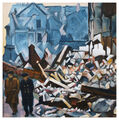The Exhibition.
The paintings in this small exhibition are something of a departure for me. My previous solo exhibitions at the Oxmarket were all informed by landscape narratives that had meaning for me. This exhibition is different, though equally meaningful, and personal.
Born in 1943, I grew up in the austerity of post war Coventry. My playgrounds were bomb sites, the remains of wartime shadow factories and the canals. As a gas engineer, my father was in a reserved occupation, as was my maternal grandfather building armoured cars and aircraft parts for the war effort. My parent’s pre-war home had been bombed during the Coventry Blitz in 1941 and they had been re-housed in a terraced house elsewhere in the city. This was the first home I remember.
Whilst clearing her bungalow after my mother died, I came across several black and white photographs and newspapers from the 1940s, some of which depicted the loss of her own home as well as some images of damage to the school that I was destined to attend. It was these images that led me to research further the Coventry Blitz and to reflect on my early childhood in Coventry
It was these thoughts and reflections that formed the starting point for the small series of paintings exhibited here. The exhibition’s title refers to the code name “Moonlight Sonata” given by the German Luftwaffe to the bombing raid on Coventry in November 1940. Of course, we are all familiar with the artistic images of the Blitz by the men and women who were given full or part-time contracts by the War Artists' Advisory Committee (WAAC). The 5,000 works produced or purchased included works by artists who were, or were to become, major figures in post-war British art. Directly or indirectly their influence on later generations has been profound. Indeed, the works in the current exhibition are in debt to their legacy.
CLICK here to access 'Further Inspiration and Validation
Further_inspiration-3
The paintings in this small exhibition are something of a departure for me. My previous solo exhibitions at the Oxmarket were all informed by landscape narratives that had meaning for me. This exhibition is different, though equally meaningful, and personal.
Born in 1943, I grew up in the austerity of post war Coventry. My playgrounds were bomb sites, the remains of wartime shadow factories and the canals. As a gas engineer, my father was in a reserved occupation, as was my maternal grandfather building armoured cars and aircraft parts for the war effort. My parent’s pre-war home had been bombed during the Coventry Blitz in 1941 and they had been re-housed in a terraced house elsewhere in the city. This was the first home I remember.
Whilst clearing her bungalow after my mother died, I came across several black and white photographs and newspapers from the 1940s, some of which depicted the loss of her own home as well as some images of damage to the school that I was destined to attend. It was these images that led me to research further the Coventry Blitz and to reflect on my early childhood in Coventry
It was these thoughts and reflections that formed the starting point for the small series of paintings exhibited here. The exhibition’s title refers to the code name “Moonlight Sonata” given by the German Luftwaffe to the bombing raid on Coventry in November 1940. Of course, we are all familiar with the artistic images of the Blitz by the men and women who were given full or part-time contracts by the War Artists' Advisory Committee (WAAC). The 5,000 works produced or purchased included works by artists who were, or were to become, major figures in post-war British art. Directly or indirectly their influence on later generations has been profound. Indeed, the works in the current exhibition are in debt to their legacy.
CLICK here to access 'Further Inspiration and Validation
Further_inspiration-3
Moonlight Sonata

18. Malvern Road II, April 1941

3. Blasted roadside trees

4. Finding a way, Jordan Well

5. Fighting a losing battle

6. Fighting fires through the night

7. Clearing the rubble, High Street:

9. The morning after

10. The spire of Holy Trinity

11. What was the High Street:

12. Feeling a little lost

13. Time for a 'cuppa':

14. Must get to work

15. Desolation Row

16. Over the rooftops

16. Fire at the Queen’s Hotel

20. Makeshift cricket ground:

21. We’ve lost everything

23. Still God’s house

24. Leaning towers in Little Park Street:

25. At least we've survived

26. Life must go on,we will survive

8. Surveying the Damage

18. Malvern Road II, April 1941

1. Collecting gasworks coke

